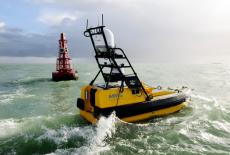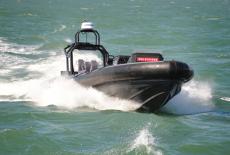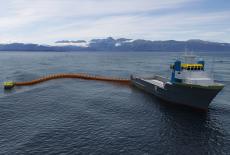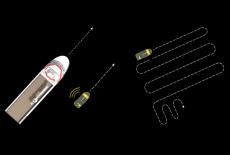Unmanned Surface Vehicles - USVs go from Concept to Service

08.02.2016
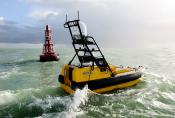
Auotonomous Technology & Unmanned Surface Vehicles
Over the next decade the maritime sector is likely to see one of the largest changes since sail gave way to steam.
Unmanned Surface Vehicles (USV) are now being considered for various marine roles and the drivers for rapid development are significant. The maritime sector now has the opportunity to shape technology developments from both legislative and end-user standpoints.
Unmanned or autonomous vessels have passed through the trial and evaluation stage and are now being adopted for civilian and military applications. As the maritime sector is often the last to adopt new technology it is important to identify genuine innovations from other transport sectors. The driverless car is being pioneered by some of the largest companies in the world including Google, and small unmanned aircraft are being considered as a delivery method for global retailers including Amazon. As these innovations pass through rigorous regulatory approval processes there will be wider acceptance from the public when they are adopted.
The military has already learned a lot about Unmanned Aerial Vehicles (UAV) and the systems required to operate them. During the war in Afghanistan the US went from a UAV inventory of 100 to 10,000 over a ten year period. There are several terms in use for unmanned aerial vehicles, including Unmanned Aircraft System (UAS) which has generally been adopted by defence and civil aviation authorities. UAS emphasizes the importance of other elements beyond an aircraft itself including ground control stations, data links and other support equipment.
The maritime sector has the opportunity to gain extensive knowledge from numerous civil aviation uses including aerial surveying of land and crops, search and rescue operations, inspecting power lines and pipelines, monitoring wildlife and delivering medical supplies to remote or otherwise inaccessible regions. Utilising fixed wing or rotor aircraft, the technology is usually referred to by aviation professionals as an Unmanned Aerial System (UAS) in preference to the military term ‘drone’.
Beneath the surface Autonomous Underwater Vehicles (AUV) operate independently of direct human input. Remotely operated underwater vehicles (ROVs) are controlled by a remote human operator and tethered by an armoured umbilical cable that carries electric power, video and data. ROV technology was developed in the 1960’s to perform deep sea rescue operations and recover objects from the ocean floor. The offshore oil & gas industry created work-class ROVs to assist in the development of offshore oil fields.
Small Unmanned Surface Vehicles Lead The Way
On the surface the COLREGS (International Regulations for Preventing Collisions at Sea) are a major and ongoing issue as mariners and legislators debate whether unmanned vessels can operate safely in the vicinity of manned vessels. While confidence is building in the wider shipping community a USV platform is required that will do minimum damage to another vessel if a collision should occur. Small, light vessels often with inflatable or foam collars, have tended to be used to prove the unmanned concept. Creating defined sea and waterway areas where unmanned vessels can operate will enable further evaluation of their capabilities.
The first adopted vessels are mainly in the sub 12 metre (40 feet) range. The vessel technology is mature in this size range with numerous hull forms to choose from. The sensor technology is also mature and aviation has proved that it can be fitted into relatively small platforms then deployed over long distances.
These small, lightweight vessels are flexible enough to fulfil a number of roles, plus their size and weight characteristics enable them to be easily transported by road, rail and air. Lightweight advanced materials, including composites, for hull and superstructure are likely to become the norm as this enables the onboard technology or fuel payload to be greater.
Davit and crane lifting specifications plus storage space on mother vessels are important considerations that for now will keep USV dimensions similar to current deployed vessels such as ships boats. Launch and recovery is a challenge for any unmanned platform and this will be important when integrating USV activities with larger ships when underway. Launch is the easier part of the process but there is still the issue of releasing the USV and pulling away from the suction effect of the mother vessel. Recovery can result in damage from collision with the mother vessel. Potential solutions range from simple nets to sophisticated high tech capture systems.
Civilian roles include surveying, scientific research and pollution response. The likelihood is that the oil and gas sector will lead the adoption of this technology. As this industry is highly regulated and risk adverse this will raise confidence for the wider maritime community. Port security is likely to expand the use of fixed location CCTV and situational awareness technology to mobile unmanned platforms that can patrol specific locations or cover large areas of a harbour on a 24/7 basis in all weathers. Military roles include Intelligence Surveillance & Reconnaissance (ISR), target practice and mine hunting with a growing desire to explore all possibilities to keep personnel out of harm way.
Unmanned Boat Design and Systems Integration
The innovators of first generation USVs tended to use existing floating platforms ranging from plastic kayaks to RHIBs to accommodate bespoke electronics and controls in waterproof housings. Once command, control and communication had been proven the next generation of USV developers required bespoke craft to demonstrate task specific applications. From the naval architect and boat builders perspective there have been opportunities to adapt proven craft and for new designs which have evolved into the USVs that are available today. COTS (Commercial Off The Shelf) procurement is now driving many military and government decisions, therefore the objective will be to create standardised marine platforms that can easily be adapted to carry modular technology payloads as the vessels role changes. This may include switching vessels from unmanned to manned as the task requires.
As the industries of boat building and autonomous system development are so different, it is proving essential to develop strategic alliances to enable cost effective systems integration. The industry recognises that a key enabler will be getting the systems architecture right from the start. A well designed open architecture will provide a flexible and modular system that can be expanded incrementally.
US based Liquid Robotics has a vision to instrument the ocean with fleets of networked, wave-powered ocean robots. Wave motion is greatest at the water’s surface, decreasing rapidly with increasing depth. The Wave Glider’s unique two-part architecture exploits this difference in motion to provide forward propulsion. Wave Gliders have spent over 15,000 days at sea with the longest mission covering over 9,000 nautical miles. The Liquid Robotics Open Oceans Partner Program is a global technology program designed to accelerate the creation, integration and deployment of new technologies and applications for unmanned ocean systems. Building upon the Wave Glider, the world’s first wave and solar powered ocean robot, this program offers participating partners a comprehensive suite of open integration and development tools. Gary Gysin, President and CEO of Liquid Robotics, said, ‘We are bringing the open systems, rapid innovation model of Silicon Valley to a maritime world of special purpose systems. Working with our partners, we will create entirely new solutions for defense, commercial and scientific customers by opening up access to the world of maritime systems.’
Autonomous Vessels and the Ocean Environment
In November 2015 a brand new Marine Robotics Innovation Centre was opened in Southampton UK. Run by the National Oceanography Centre the centre will be will be a hub for businesses and technologists developing autonomous platforms with novel sensors that will be used to cost-effectively capture data from the world’s oceans. One of the first occupants is UK based company ASV, a leading provider of unmanned vessels with more than seventy platforms in the field globally and a wide variety of associated payloads. ASV designs, builds and operates a range of platforms for industrial, scientific and military applications worldwide.
The first use of an Autonomous Surface Vehicle (ASV) to perform bathymetry for updating the US nautical charts for NOAA (National Oceanic and Atmospheric Administration Office) occurred in the Alaskan Arctic in the summer of 2015. Surveying alongside TerraSond’s mother-vessel, the ASV collected data simultaneously on adjacent survey lines, effectively doubling the production rate. The ASV also surveyed by itself in areas too shallow and dangerous for the larger vessel to work. Tom Newman, President of TerraSond, said, ‘This is a force-multiplier for data acquisition. Operated in a semi-autonomous mode, unmanned but supervised, one person can replace the three person crew it would normally take to operate a survey launch. It is definitely the future of seafloor mapping.’
Unmanned Capability Enhances Naval Operations
Unmanned technology with the potential to change the face of naval operations within a decade has successfully been demonstrated for the first time by BAE Systems in partnership with ASV at a site near Portsmouth Naval Base. The new system will allow crews to carry out vital tasks such as high speed reconnaissance and remote surveillance while keeping sailors out of harm’s way. The technology is designed to be fitted to the RHIBs already used extensively by the Royal Navy. The modified boat is capable of operating autonomously for up to 12 hours at a time, on either a pre-planned route or via remote control. It can reach speeds in excess of 38 knots, providing unique ship-launched manoeuvrability and enhanced situational awareness to support the decision-making of its operators.
Underpinning the system’s ability to operate autonomously is its complex array of sensors, including a navigation radar, 360 degree panoramic infrared camera array and laser range finder. Dan Hook, Managing Director of ASV, said, ‘The algorithms that we are developing with BAE Systems allow the boat to perform complex missions and navigate through waters avoiding collisions. This gives it the flexibility and sophistication to operate in a number of different tactical roles, whether it’s patrolling areas of interest, providing surveillance and reconnaissance ahead of manned missions, or protecting larger ships in the fleet.’
Les Gregory, Product and Training Services Director at BAE Systems, said, ‘This technology delivers an extremely robust and fast-moving unmanned boat that is able to perform a number of surveillance and reconnaissance roles, even when operating at high speed or in choppy water. While other programmes are primarily designed for larger, slower boats to tackle mine counter-measure scenarios, this system provides an extremely manoeuvrable multi-role vessel.’
In 2015 Atlas Elektronik UK were awarded a contract by the UK Ministry of Defence to supply an autonomous minesweeping capability to the Royal Navy. The ARCIMS mission system, based on a specially designed 11 metre (36 feet) vessel, can be operated from shore with the minimum of support or launched and recovered from an RN Hunt Class mine countermeasure vessel. These USVs will create underwater influences to detonate mines in a controlled manner. The system will include autonomous ‘Sense & Avoid’ capability to enable safe operations at sea. The benefits of these modern unmanned sweeping systems are that they can safely clear sea lanes from mines therefore removing the ‘man from the minefield.’
Dull, Dirty and Dangerous Tasks for Workboats
US based company Sea Machines are developing unmanned work boats for a number of applications in the maritime and offshore industries. Sea Machines Autonomous Control Systems (ACS) provide algorithmic supervised autonomous control to enable unmanned operations of a vessel relative to a local base station or mother ship.
The ACS is designed to perform repetitive and quantifiable marine tasks more reliably when compared to direct human control. Michael Gordon Johnson, Sea Machines CEO, likens their new control system to the advances made by Dynamic Positioning (DP), ‘A skilled master can keep a vessel in position, but it is much easier for a computer to do it. Sea Machines system is a further advancement beyond DP. The next step is to have unmanned vessels working beyond the line of sight using satellite communications.’
Regarding utilising unmanned vessels for oil spill operations Johnson added, ‘The challenge is that you never know where the spill is going to occur. Typically what happens is that boats of convenience and crews of convenience are used, which is not necessarily the most efficient outcome. Working surrounded by crude oil is absolutely miserable, it is also hazardous and can cause health problems.’
Creating vessels and systems that can perform dull, dirty and dangerous tasks has been a driver for many of the vessels that we have seen introduced to date. With autonomous systems highlighted as one of the most significant technologies for the future, this current crop of small unmanned vessels are only the tip of the iceberg for the maritime sector.
By John Haynes
The author is an Associate Fellow of the Nautical Institute, Yachtmaster Ocean and Advanced Powerboat Instructor. Subject matter expertise includes high speed craft consultancy, strategic product development and specialist training.
Images
- ASV C-Worker 6 is a multi-role work class ASV suitable for a variety of tasks.
- BAE Systems Unmanned RHIB with ASV Technology. Credit BAE Systems.
- Sea Machines V1 is designed for J-Towing of booms for oil spill response.
- Sea Machines USV Collaborative Following and Planned Survey Tracking.
Unmanned Surface Vehicles go from Concept to Service by John Haynes
All images are copyright RIB & HSC 2024 unless otherwise stated.
This does not exclude the owner's assertion of copyright over the material.

09.07.2024
NEXT GEN Marine BATTERY Workshop via Teams
NEXT GEN Marine BATTERY Workshop is being held via…
05.01.2024
The Challenges of Unpredictable Marine Energy
From military to superyacht, it is clear there is an urgent…
Southampton International Boat Show 2024
Dates:
13 to 22 September 2024
Location:
Southampton UK
Foiling and Flying RIBs
Foiling powerboat designed to meet military needs - fast, stable, silent, fuel-saving. Collaboration by SEAir Foiling Systems and Sillinger RIBs.…














